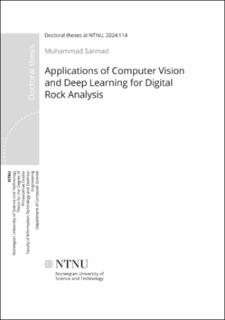| dc.contributor.advisor | Lindseth, Frank | |
| dc.contributor.advisor | Ruspini, Leonardo | |
| dc.contributor.advisor | Kiss, Gabriel | |
| dc.contributor.author | Sarmad, Muhammad | |
| dc.date.accessioned | 2024-04-16T10:31:44Z | |
| dc.date.available | 2024-04-16T10:31:44Z | |
| dc.date.issued | 2024 | |
| dc.identifier.isbn | 978-82-326-7821-1 | |
| dc.identifier.issn | 2703-8084 | |
| dc.identifier.uri | https://hdl.handle.net/11250/3126759 | |
| dc.description.abstract | Digital rock analysis utilizes various tools available in computer science to represent and process rock data in a way that enhances our understanding of its geological properties. It has become an essential tool for understanding rock samples’ physical and chemical properties, which is crucial for exploration and production. It is a multi-step process that includes image acquisition, registration, superresolution and segmentation. This thesis proposes various methods to improve the individual steps in this process to improve the overall digital rock analysis workflow.
One of the most critical steps in digital rock analysis is obtaining representative and high-quality rock images. This step is necessary for high accuracy in downstream tasks such as fluid flow simulations. The imaging of rock samples is done via micro-computed tomography (micro-CT) or electron microscopy. The resolution of the images obtained from micro-CT scanning can often be limited for a specific task requiring electron microscopes. However, using an electron microscope presents its own challenges, such as high cost and limited field of view.
First of all, this thesis addresses the limitations in the image acquisition process with the help of upsampling the low-resolution rock images. This process is called image super-resolution. Two deep learning-based super-resolution methods have been presented in the first two papers in this work that can potentially improve the digital rock workflow by enhancing image quality.
A critical and time-consuming aspect of digital rock analysis is image registration, which aligns multiple images of the same rock sample. Without registration, correlating different images of the same rock samples is impossible. The algorithm developed in the third paper, a rigid 3D-3D registration algorithm, is a tool that can finish a registration job in seconds instead of hours taken by current industrial image registration tools.
A rock sample can contain multiple mineral types and regions with different prop erties. Accurately identifying those regions is the first step in determining the properties of the individual parts and, eventually, the whole sample. Rock typing is the process of identifying those regions. It is an essential step in digital rock workflow, commonly performed manually. The second last paper in this thesis presents a deep learning-based method that takes the first steps towards improving the rock typing of laminar rocks.
Scanning the rock samples is costly and time-consuming. Therefore, it is attractive to use deep generative models to generate a representative sample of digital rocks that can be utilized in the workflow. In the fifth and final paper, this thesis presents a novel Diffusion model-based 2D to 3D image generation method. Using the proposed method, a complete 3D image of a rock can be generated using only a single 2D slice, thus addressing the scarcity of 3D data.
In summary, the contributions of this thesis improve the various steps involved in the digital rock analysis workflow using deep learning and conventional computer vision-based methods. | en_US |
| dc.language.iso | eng | en_US |
| dc.publisher | NTNU | en_US |
| dc.relation.ispartofseries | Doctoral theses at NTNU;2024:114 | |
| dc.relation.haspart | Paper A:
Sarmad, Muhammad; Ruspini, Leonardo Carlos; Lindseth, Frank.
Photo-Realistic Continuous Image Super-Resolution with Implicit Neural Networks and Generative Adversarial Networks https://doi.org/10.7557/18.6285 This is an open access article distributed under the terms and conditions of the Creative Commons Attribution license (http://creativecommons.org/licenses/by/4.0/). | en_US |
| dc.relation.haspart | Paper B: Sarmad, Muhammad; Ruspini, Leonardo Carlos; Lindseth, Frank. SIT-SR 3D: Self-supervised slice interpolation via transfer learning for 3D volume super-resolution. Pattern Recognition Letters 2023 ;Volum 166. s. 97-104 https://doi.org/10.1016/j.patrec.2023.01.008 This is an open access article under the CC BY license ( http://creativecommons.org/licenses/by/4.0/ ) | en_US |
| dc.relation.haspart | Paper C:
Sarmad, Muhammad; Phan, Johan; Ruspini, Leonardo; Kiss, Gabriel; Lindseth, Frank.
GPU Assisted Fast and Robust 3D Image Registration of Large Wet and Dry Rock Images Under Extreme Rotations | en_US |
| dc.relation.haspart | Paper D:
Sarmad, Muhammad; Phan, Johan; Ruspini, Leonardo; Kiss, Gabriel; Lindseth, Frank.
Core-Scale Rock Typing using Convolutional Neural Networks For Reservoir Characterization in the Petroleum Industry. Proceedings of 23rd International Multidisciplinary Scientific GeoConference SGEM 2023 https://doi.org/ 10.5593/sgem2023/1.1/s06.78 | en_US |
| dc.relation.haspart | Paper E: Phan, Johan; Sarmad, Muhammad; Ruspini, Leonardo Carlos; Kiss, Gabriel Hanssen; Lindseth, Frank. Generating 3D images of material microstructures from a single 2D image: a denoising diffusion approach. Scientific Reports 2024 ;Volum 14.(1) https://doi.org/10.1038/s41598-024-56910-9 This is an open access article under the CC BY license ( http://creativecommons.org/licenses/by/4.0/ ) | en_US |
| dc.title | Applications of Computer Vision and Deep Learning for Digital Rock Analysis | en_US |
| dc.type | Doctoral thesis | en_US |
| dc.subject.nsi | VDP::Technology: 500::Information and communication technology: 550 | en_US |
